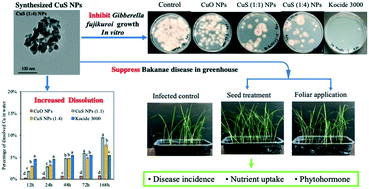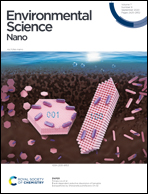Copper sulfide nanoparticles suppress Gibberella fujikuroi infection in rice (Oryza sativa L.) by multiple mechanisms: contact-mortality, nutritional modulation and phytohormone regulation†
Abstract
The use of nanotechnology to suppress crop diseases is gaining increasing interest in agriculture. Copper sulfide nanoparticles (CuS NPs) were synthesized at 1 : 1 and 1 : 4 ratios of Cu and S and their respective antifungal efficacy was evaluated against the pathogenic activity of Gibberella fujikuroi (bakanae disease) in rice (Oryza sativa L.). In a 2 d in vitro study, CuS (1 : 1) and CuS (1 : 4) NPs at 50 mg L−1 decreased G. fujikuroi colony-forming units (CFU) by 35.7 and 33%, respectively, compared to controls; commercial CuO NPs caused an 18.7% inhibition. In a greenhouse study, treating with both types of CuS NPs at 50 mg L−1 at the seed stage significantly decreased disease incidence on rice by 35.1 and 45.9%, respectively. Comparatively, CuO NPs achieved only 8.1% disease reduction, and the commercial Cu-based pesticide Kocide 3000 had no impact on disease. Foliar-applied CuO NPs and CuS (1 : 1) NPs decreased disease incidence by 30.0 and 32.5%, respectively, which outperformed CuS (1 : 4) NPs (15%) and Kocide 3000 (12.5%). Notably, CuS (1 : 4) NPs also modulated the shoot salicylic acid (SA) and jasmonic acid (JA) production to enhance the plant defense mechanisms against G. fujikuroi infection. These findings provide useful information for improving the delivery efficiency of agrichemicals via nano-enabled strategies while minimizing their environmental impact, and advance our understanding of the defense mechanisms triggered by the NPs presence in plants.

- This article is part of the themed collection: Nano-bio interactions


 Please wait while we load your content...
Please wait while we load your content...
